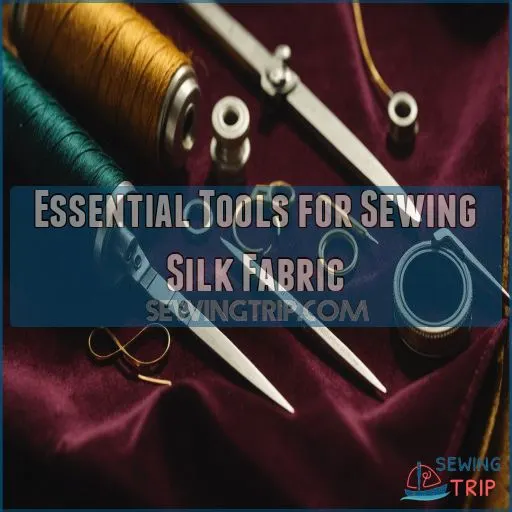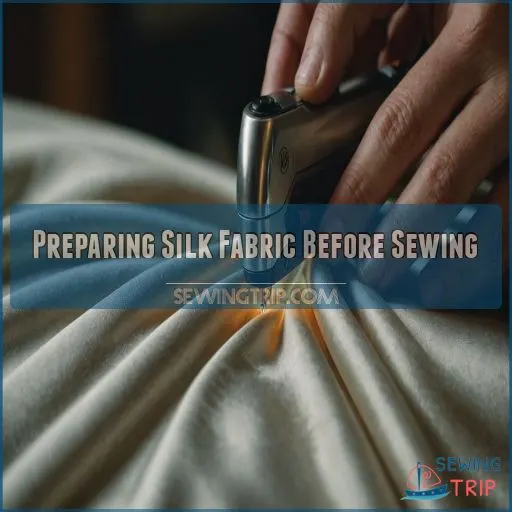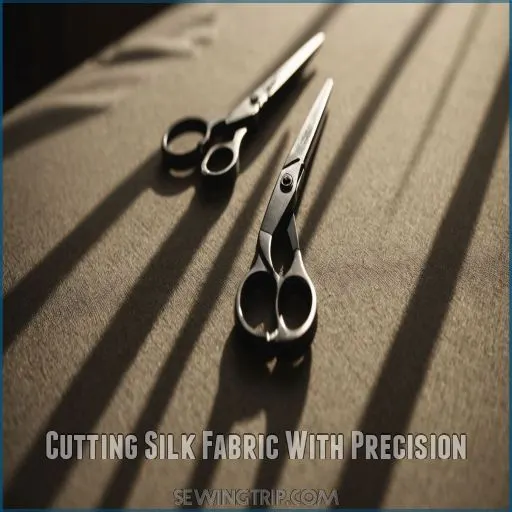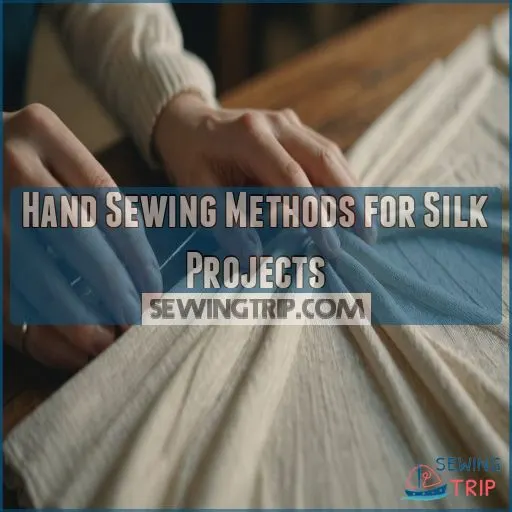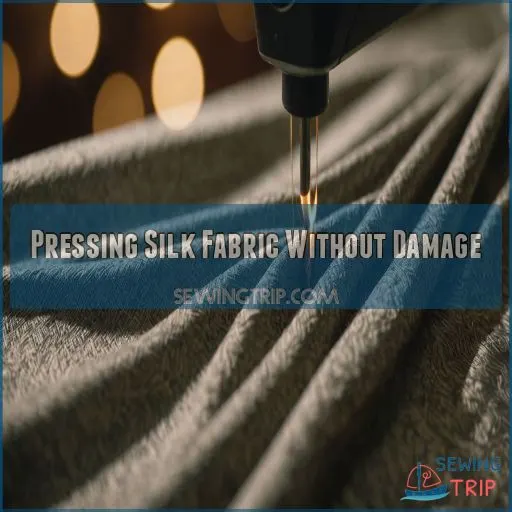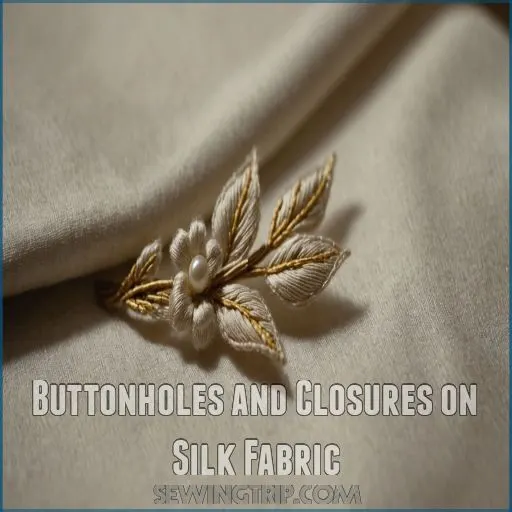This site is supported by our readers. We may earn a commission, at no cost to you, if you purchase through links.

Pre-wash your silk to prevent surprises, and consider stiffening it with a gelatin solution for easier handling.
When cutting, sandwich the fabric between tissue paper for precision. Use a longer stitch length and lower tension when sewing to avoid puckering, as recommended in choosing the right thread
.
Remember, silk can be slippery, so take your time and use plenty of pins. French seams are your friend for a polished finish.
With these sewing silk fabric tips, you’ll be crafting luxurious garments in no time. But wait, there’s more to unravel about this delicate fabric…
Table Of Contents
- Key Takeaways
- Essential Tools for Sewing Silk Fabric
- Preparing Silk Fabric Before Sewing
- Cutting Silk Fabric With Precision
- Machine Sewing Techniques for Silk Fabric
- Hand Sewing Methods for Silk Projects
- Pressing Silk Fabric Without Damage
- Hemming Options for Silk Garments
- Working With Challenging Silk Varieties
- Buttonholes and Closures on Silk Fabric
- Finishing Touches for Silk Projects
- Frequently Asked Questions (FAQs)
- Conclusion
Key Takeaways
- You’ll tame silk’s slippery nature by sandwiching it between tissue paper when cutting and using a walking foot while sewing. It’s like giving your fabric "training wheels."
- Don’t let silk intimidate you – embrace French seams as your new best friend. They’ll give your garments a polished, professional finish that will make you feel like a couture designer.
- Your iron isn’t the enemy, but it needs a chaperone. Always use a pressing cloth and keep the heat low. Think of it as giving your silk a spa treatment, not a torture session.
- Patience is your secret weapon. Take your time with hand-basting, practice on scraps, and remember that even the pros started somewhere. You’re not just sewing; you’re crafting wearable art.
Essential Tools for Sewing Silk Fabric
You’ll need the right tools to tame silk’s slippery nature and create beautiful garments.
From fine needles to specialized presser feet, having the proper equipment makes all the difference when working with this luxurious fabric.
Needle Selection for Silk
Choosing the right needle is key to mastering silk sewing. You’ll want a fine, sharp needle to glide through delicate fibers without snagging.
For machine sewing, opt for a size 70/10 Schmetz Sharp needle . When hand-sewing, select:
- Beading needles for precision work
- Thin dressmaker pins (1 1/4" long) for pinning
- A well-fitted thimble for your dominant hand’s middle finger
Remember, the higher the needle number, the finer the point. Match your needle to your silk’s weight for best results.
Best Thread Types for Silk
Thread choice can make or break your silk project. Opt for fine polyester or cotton thread with a weight of 50-60 for most silk fabrics. While silk thread might seem logical, it’s too slippery for general sewing.
Instead, use silk thread for basting. Match thread color to your fabric or go a shade darker for less visibility.
Adjust your machine’s tension and use 8-10 stitches per inch for a polished finish.
Sewing Machine Feet for Delicate Fabrics
Now that you’ve got your thread sorted, let’s talk about the unsung heroes of silk sewing: machine feet.
Your regular foot might bully delicate fabrics, so it’s time to bring in the specialists.
A walking foot is your new best friend, keeping layers from shifting as you sew.
For those tricky hems, try a roller foot – it’ll glide over silk like butter on a hot pan.
Scissors and Rotary Cutters for Silk
Your precision tools are the unsung heroes when working with silk. Sharp scissors and rotary cutters are your best friends here.
For scissors, opt for serrated shears like Gingher’s to prevent fabric shifting. When using a rotary cutter, always start with a fresh blade.
Using a rotary cutter or sharp shears for clean, precise edges is essential, as it helps prevent fraying and gives your silk fabric a professional finish.
Don’t forget your self-healing mat – flip it over if it’s well-worn to guarantee clean cuts. Your silk will thank you!
Preparing Silk Fabric Before Sewing
Before you start sewing your silk fabric, you’ll need to prepare it properly.
You’ll want to pre-wash, stiffen, and level your silk to guarantee the best results when you work with this delicate material.
Pre-washing Silk
Before diving into your silk sewing project, take a moment to pre-wash your fabric. This important step prevents future shrinkage and color bleeding, giving you control over your garment’s final fit.
Fill your sink with lukewarm water and gentle detergent, like baby shampoo . Soak the fabric for 10 minutes, rinse thoroughly, and air dry.
For delicate silks, consider professional dry cleaning to maintain that luxurious feel in your silk dress or robe.
Stiffening Techniques for Easier Handling
Taming slippery silk can feel like wrestling an eel, but stiffening techniques are your secret weapon.
Mix one teaspoon of gelatin with 16 ounces of water for a game-changing solution .
Soak your fabric, hang to dry, and voila – you’ve got manageable silk without compromising drape .
For extra-slippery types, double the gelatin.
This temporary fix washes out, leaving your silk supple and ready to wear.
Leveling and Blocking Silk
Now that you’ve stiffened your silk, it’s time to level and block it. This step makes sure your fabric lays flat and even.
Here’s how:
- Lay your silk on a blocking board or padded surface
- Use T-pins to gently stretch and secure the edges
- Steam lightly, allowing the fabric to settle and relax
Remember, silk’s drape can be finicky. Give it time to adjust after blocking. For stubborn wrinkles, try the hot shower trick – hang your silk in the bathroom while you shower.
Testing Treatments on Fabric Swatches
You’ve leveled your silk, but don’t jump the gun just yet. Grab some fabric swatches and put them through their paces. Test for colorfastness, shrinkage, and hand feel changes.
Choosing the right needle, such as microtex needles, can also make a big difference in preventing damage to your silk fabric, using the correct needles.
Additionally, opt for natural fibers like silk for sensitive skin. Cut a small square, apply your planned treatments, and observe the effects.
Does the fabric pucker? Will your seam allowance hold up? Try a stay stitch or serged finish on the edges.
A little fray check can go a long way in preventing fraying disasters.
Cutting Silk Fabric With Precision
You’ll need a steady hand and sharp tools to cut silk fabric with precision.
Master these techniques to prevent fraying and guarantee your silk pieces are cut accurately for a flawless finish with perfect edge finishing methods
.
Single-layer Cutting Methods
Ready to cut silk like a pro?
Let’s talk single-layer methods.
Sandwich your silk between two sheets of tissue paper. This trick keeps your fabric on grain and prevents slipping.
Use a rotary cutter on a cutting mat for precise edges.
Pin the selvedge to your paper first, then align your pattern pieces. You’ll feel like you’re cutting through butter, not silk, like a pro!
Transferring Pattern Markings to Silk
After cutting your silk, it’s time to transfer those important pattern markings. Silk’s delicate nature calls for a gentle touch.
Here are some silk-friendly marking methods:
- Tailor’s tacks: Thread loops that won’t damage fabric
- Dressmaker’s carbon paper: Leaves faint lines with tracing wheel
- Chaco liners: Precision marking with chalk dust
- Soap tracing: An old-school trick that washes out easily
Remember, silk’s slippery surface can make marking tricky. Take your time and choose the method that gives you the most control.
Preventing Fabric Shifting While Cutting
Slippery silk fabric can be as elusive as a fish in water when cutting. To tame this tricky textile, use these stabilizing techniques:
| Method | Application |
|---|---|
| Paper sandwich | Place tissue paper above and below silk |
| Weights | Use pattern weights to anchor fabric |
| Single-layer cutting | Cut one layer at a time for precision |
| Fabric table cover | Lay a bed sheet on your cutting table |
Remember, patience is key. Take your time and you’ll slice through silk like a hot knife through butter.
Grain Line Considerations for Silk
Now that you’ve got your silk under control, let’s talk about the fabric’s grain line. It’s like the secret roadmap of your silk.
Align it correctly, and you’ll tap into the fabric’s true potential.
For a classic look, follow the lengthwise grain.
Want some drama? Go for a bias cut – it’ll make your silk flow like water.
Remember, the grain line affects how your garment drapes and behaves, so choose wisely.
Machine Sewing Techniques for Silk Fabric
You’ll need to adjust your machine settings to sew silk fabric successfully when using the right hemming techniques
.
Use a shorter stitch length, finer needle, and gentle handling to prevent shifting and damage.
While creating beautiful seams.
Optimal Stitch Length and Width
You’ve cut your silk fabric with precision, and now it’s time to sew. Getting the right stitch length and width is key to achieving that perfect drape. For silk, you’ll want to increase your stitch length to about 3.0 and adjust the width to around 4.0-4.3. This combo gives you stability without compromising the fabric’s flow.
Here are four tips to nail your stitches:
- Test on scraps first
- Use a longer stitch for easier removal
- Adjust tension for silk’s delicacy
- Consider hand-sewing for ultimate control
Remember, silk’s like a temperamental diva – treat it right, and it’ll make you look like a star!
Preventing Fabric Layers From Shifting
Silk’s slippery nature can turn your sewing project into a skating rink.
To keep those layers in check, start by pinning perpendicular to the raw edge. This locks the fabric in place better than parallel pins.
For extra security, try nesting your seams – press them in opposite directions so they interlock.
Hand basting with silk thread is another trick up your sleeve; it slides out easily without damaging the fabric.
Dealing With Fabric Feeding Issues
When sewing silk, fabric feeding issues can feel like wrestling with a slippery eel. Don’t let your silky dreams unravel! Tame those feeding gremlins with these tricks:
- Adjust your machine’s tension for the perfect
Seam Finishes for Silk Garments
Mastering seam finishes on silk elevates your garments to couture-level perfection, especially when using silk pressing techniques
. For a sleek look, try French seams on straight edges and mock French seams for curves like armscyes, especially when sewing curved edges
. Hong Kong seams add a touch of luxury, especially with silk bias tape.
For casual projects, use a 3-thread serger setup to reduce bulk.
Don’t shy away from hand-sewn options; a whipped seam creates a fluid, weightless finish.
Hand Sewing Methods for Silk Projects
Hand sewing silk requires patience and precision, but it’s worth the effort for a flawless finish.
You’ll learn essential techniques like basting, hand-rolled hems, French seams, and invisible stitching to elevate your silk projects.
Basting Techniques for Silk
Now that you’ve mastered machine sewing, let’s talk basting.
It’s your secret weapon for taming slippery silk. You’ll want to use hand basting techniques for ultimate control.
Here are three game-changing tips:
- Use contrasting thread for easy removal
- Try the uneven basting stitch for underlining
- Opt for silk thread to avoid imprints when pressing
Remember, basting is like a dress rehearsal for your seams. It’s your chance to perfect before the final performance.
Hand-rolled Hem Instructions
To roll out a perfect hand-rolled hem, you’ll need a few key tools: a sharp needle, fine thread, and steady hands.
Start by folding the edge 1/4" in the direction of the wrong side. Pick up a single thread from the fabric, then take a tiny stitch from the fold’s edge.
Repeat this process for an inch, then gently pull the thread.
Watch as your silk magically rolls into a neat, invisible hem, with a tiny stitch.
French Seams by Hand
Hand-sewn French seams take your silk projects to the next level. They’re perfect for finishing edges and creating durable, professional-looking seams. To achieve this, using a thread color that blends seamlessly with the fabric’s dominant color, ideally a shade darker for a foolproof choice, is essential.
Additionally, setting your stitch length around 2.5 mm for durability, as seen in French seam techniques, is also important.
You’ll start by sewing wrong sides together, then flip and stitch again. It’s like magic – your raw edges disappear!
Here’s what you need to know:
- Choose lightweight fabrics for best results
- Allow extra seam allowance for tucking
- Practice on scraps to perfect your technique
- Use fine needles and thread to minimize visible stitching
Invisible Stitching on Silk
Achieving invisible stitches on silk is like performing magic with needle and thread.
You’ll want to use a fine needle and silk thread for this couture finish.
Start by folding the edge under twice, then catch just a few threads of the fabric with each stitch. Work from right to left, spacing stitches evenly.
Remember, less is more – your stitches should be barely there, like a whisper on the fabric .
Pressing Silk Fabric Without Damage
Pressing silk fabric requires a gentle touch to avoid damage. You’ll need to use the right tools and techniques to achieve a crisp finish without leaving marks or causing shine.
Using Pressing Cloths Effectively
Before your iron meets silk, always use a pressing cloth. It’s your fabric’s bodyguard against shine and scorch marks.
Silk organza is your best bet – it’s transparent, so you can see exactly where you’re pressing. For delicate silks, sandwich your fabric between two cloths.
Pressing cloths aren’t just for show; they’re essential for protecting your silk and preserving its luxurious feel. Don’t let laziness lead to a pressing disaster!
Temperature Settings for Different Silk Types
Now that you’ve got your pressing cloth ready, let’s talk temperature. Different silk types can be as finicky as a cat in a bathtub regarding heat. You’ll need to adjust your iron’s settings to avoid turning your fabric into a shiny, damaged mess.
Here’s a quick guide to help you navigate the temperature tightrope:
- Light silks (chiffon, organza): Low heat (250°F)
- Medium silks (crepe de chine): Medium-low heat (300°F)
- Heavy silks (dupioni, shantung): Medium heat (350°F)
- Thick silks (charmeuse): Medium-high heat (375°F)
- Always test on a scrap first!
Remember, it’s better to err on the cooler side and work your way up. You can always add more heat, but you can’t un-scorch silk!
Pressing Techniques for Bias-cut Silk
When pressing bias-cut silk, you’re walking a tightrope between crisp and crushed.
Set up your ironing board with a pressing cloth to protect the delicate fabric.
Adjust your iron’s steam settings to low; too much can warp the bias grain.
Gently press, don’t iron, to maintain the fabric’s natural drape.
Remember, bias-cut silk is like a temperamental diva – treat it with care, and it’ll shine on stage.
Avoiding Shine and Fabric Impressions
Sheen and impressions can be the bane of silk pressing. To keep your fabric pristine, use a pressing cloth between the iron and silk. Set your iron to low heat, around 110°C to 150°C. Don’t drag the iron; instead, gently press in sections.
For extra protection, try these tricks:
- Use silk organza as a transparent pressing cloth
- Iron silk while it’s slightly damp
- Place a clean white sheet over your ironing board
- Consider a Teflon sheet for synthetic blends
Hemming Options for Silk Garments
Hemming silk garments can be tricky, but you’ve got several options to create a polished finish.
You can choose from machine rolled hems for speed, serger rolled hems for efficiency, hand-sewn invisible hems for a couture look, or bias tape finishing for a clean edge.
Each technique suited to different silk types and project needs.
Machine Rolled Hems on Silk
You’ve got this! Machine rolled hems on silk can be tricky, but with the right approach, you’ll nail it.
Use a narrow hem foot and lengthen your stitch slightly . For lightweight silks, try disengaging the knife and lightening presser foot pressure.
Feed the fabric evenly, especially on curves, to prevent bunching or stretching. A brand new needle and careful tension adjustment will help you achieve that professional, barely-there hem finish you’re after with a narrow hem foot.
Serger Rolled Hem Technique
Ready to elevate your silk hems? Set your serger for a rolled hem with the right needle only and shortest stitch length.
Adjust differential feed to normal to prevent puckering. For delicate fabrics, use lightweight thread in a matching color.
Remember, this technique works best on bias-cut edges . If you encounter wavy edges, increase differential feed for a smoother finish.
With practice, you’ll master this professional-looking hem.
Hand-sewn Invisible Hems
For a couture finish, hand-sewn invisible hems are your secret weapon. Thread a needle with matching silk thread and knot the end.
To achieve a virtually invisible stitch, consider using a blind stitch or whipstitch, both of which are ideal for delicate fabrics like silk how to hem a shirt by hand.
Fold the hem twice, hiding raw edges. Working from the right side, make tiny stitches catching only a few threads of the fabric. Space stitches evenly, about 1/4 inch apart.
Pull gently to avoid puckering. Your hand stitching will disappear, leaving a flawless hem.
Bias Tape Finishing for Silk Edges
With silk edges, bias tape finishing is your secret weapon for a polished look. Choose narrow tape, about 6-15mm wide, to avoid weighing down delicate fabric.
Pin the tape right sides together with your silk edge, then stitch with a 1/4" seam allowance.
Wrap the tape over, pin, and stitch in the ditch for a clean finish. It’s like giving your silk a sleek frame!
Working With Challenging Silk Varieties
You’ll encounter various silk types that can test your sewing skills, from slippery charmeuse to delicate chiffon.
Each variety requires specific techniques, but with practice, you’ll master working with even the most challenging silk fabrics.
Sewing Slippery Silk Charmeuse
Sewing slippery silk charmeuse can be a challenge, but don’t let it slip through your fingers!
Tame this fabric with these tricks:
- Cut with weights and a rotary cutter
- Hand baste darts and seams before machine stitching
- Use silk thread or cotton embroidery thread for construction
- Consider French seams for a clean finish
Choose the smallest needle you can thread, like a size 10 quilter’s needle. You’ll be conquering charmeuse in no time!
Handling Delicate Silk Chiffon
Silk chiffon can be as slippery as a wet bar of soap, but don’t let that scare you off.
To tame this wispy fabric, start by sandwiching it between tissue paper when cutting. Using a stabilizer like tear-away or wash-away can also provide support and prevent stretching.
For instance, using the right tools for sewing chiffon can make a huge difference in the quality of your stitches.
For layering techniques, use fine silk pins or better yet, baste your pieces. You’ll feel like a fabric whisperer in no time!
Techniques for Thick Silk Dupioni
Thick silk dupioni demands a different approach than its delicate cousins. You’ll find this fabric has a mind of its own, but with the right techniques, you can tame it like a pro.
Here’s how to master dupioni:
- Use a longer stitch length (2-2.5mm) to prevent puckering
- Try French seams for a clean finish and to control fraying
- Consider a Teflon foot to glide smoothly over the fabric
- Press carefully to avoid shine – use a pressing cloth and low heat
Managing Stretchy Silk Knits
You’ve mastered thick dupioni, now let’s tackle stretchy silk knits. These fabrics can be tricky, but with the right approach, you’ll breeze through your projects.
Use a narrow zigzag or lightning bolt stitch for seams that move with the fabric (Source).
Here’s a quick guide to help you navigate silk knits:
| Technique | Purpose |
|---|---|
| Ball point needles | Prevent fabric damage |
| Clear elastic | Stabilize shoulders |
| Twin needles | Create stretchy hems |
| Fabric doubling | Increase stability |
Buttonholes and Closures on Silk Fabric
Creating buttonholes and closures on silk fabric can be tricky, but with the right techniques, you’ll achieve professional results.
You’ll learn how to stabilize silk for buttonholes, master the bound buttonhole technique.
You’ll also learn how to sew zippers smoothly, and place hook-and-eye closures for a polished finish.
Stabilizing Silk for Buttonholes
Let’s tackle those tricky buttonholes on your silky creation.
To keep your fabric from slipping around like a fish out of water, try using tear-away embroidery stabilizer . It’s your secret weapon for perfect buttonholes, even on light or stretchy fabrics.
Just peel off the backing, apply it to the wrong side of your button placket, and stitch away.
When you’re done, simply tear it off for flawless results.
Bound Buttonhole Technique
Bound buttonholes add a touch of elegance to your silk garment.
Start by reinforcing the buttonhole area with interfacing. Cut bias fabric strips 4 times the desired welt width.
Fold and press these strips flat. Mark your buttonhole placement precisely, then stitch, clip corners, and turn the welts through.
Hand-stitch for a polished finish, ensuring even 3mm welts. With practice, you’ll master this refined detail.
Sewing Zippers Into Silk Garments
Zippers on silk can be tricky, but don’t sweat it!
For flawless results, start by stabilizing the seam with interfacing or stay tape. Choose an invisible zipper for a sleek look, and use a zipper foot for precise stitching.
When inserting, hand-baste first to prevent shifting.
For extra control, try hand-stitching the zipper, pulling back the teeth as you go. It’s a bit of work, but the results are worth it!
Hook-and-eye Placement on Silk
With silk, precision is key when it comes to hook-and-eye placement. Choose the right size for your garment – smaller for delicate silks, larger for heavier varieties.
Mark placement carefully, using chalk or removable fabric markers.
Reinforce the area with interfacing to prevent tearing. Sew by hand for best control, using small, tight stitches.
Always test on a scrap first to perfect your technique and guarantee a polished finish.
Finishing Touches for Silk Projects
You’re almost done with your silk project, but those final touches can make or break your creation.
Let’s explore essential finishing techniques like lining, embellishments, care instructions, and repairs to guarantee your silk garment looks and feels luxurious for years to come.
Lining Silk Garments
Your silk garment deserves a smooth finish inside and out. Choose a lining that complements your silk’s weight and drape.
Lightweight fabrics like habotai or china silk work wonders (Source). For a luxurious touch, try cupro or Bemberg (Source).
When attaching the lining, use a slip stitch to create invisible seams. Remember, the lining should float freely, allowing your silk to move gracefully. It’s like giving your garment a secret superpower – comfort and elegance combined!
Embellishment Techniques for Silk
Three stunning techniques will elevate your silk projects.
Try beading for a touch of sparkle; use small wooden beads for charming floral centers. Embroidery adds texture; blanket and stem stitches work well on silk.
For a bold statement, experiment with appliqué or lace accents.
Dyeing opens up a world of color possibilities. Remember, silk’s delicate nature requires a gentle touch, so always test techniques on scraps first.
Care Instructions for Silk Items
Silk garments require tender loving care to maintain their luxurious feel.
Hand wash your silk in cool water with gentle detergent, never wringing it out.
For storage, use padded hangers to prevent slipping.
Remove stains with a homemade solution of lemon juice or vinegar.
When ironing’s necessary, use a low setting and turn the garment inside out.
With proper care, your silk pieces will stay stunning for years.
Repairing and Mending Silk Fabric
Even with careful care, accidents happen.
When faced with silk tears, don’t panic – you’ve got options.
For small snags, use a snag repair needle to gently push loops back into place.
For larger tears, try fusible interfacing or patching with matching silk.
Remember, invisible mending is an art – take your time and use tiny stitches to blend the repair seamlessly.
With practice, you’ll mend like a pro!
Frequently Asked Questions (FAQs)
What is the best stitch for silk fabric?
Just as threads intertwine, you’ll find French seams are your silk’s best friend.
They’re ideal for delicate fabrics, encasing frayed edges and creating durable, clean-looking seams.
Use a shorter stitch length (5-5 mm) for the best results, especially for clean-looking seams.
Can you sew silk on a regular sewing machine?
You can sew silk on a regular machine with the right prep.
Use fine needles, adjust tension, and practice on scraps first. Don’t forget to hand-baste seams to tame that slippery fabric.
You’ve got this!
How do you make silk easier to sew?
Slippery silk solutions start with stabilizing. Spray starch or soak in gelatine for paper-like stiffness.
Use sharp pins, fine needles, and a shorter stitch length.
Pre-wash to prevent water marks, and consider hand-basting seams for easier machine sewing.
How to stabilize silk for sewing?
Spray stabilizer is your secret weapon for taming slippery silk.
Pre-wash your fabric, then mist it with stabilizer before cutting and sewing.
It’ll give you paper-like control, washing out later to restore that dreamy drape.
How to prevent silk from fraying while sewing?
Tackle silk’s fraying nature head-on!
Fuse lightweight interfacing to edges before cutting.
For a pro finish, try French or Hong Kong seams.
Don’t forget the trusty pinking shears – they’ll leave you with neat, zig-zagged edges.
Can I use a serger on silk fabric?
You can use a serger on silk, but it requires care.
Adjust settings for a 2-thread rolled hem, use light thread, and sew slowly.
Test on scraps first.
For tricky fabrics, try tissue paper underneath.
What thread tension is best for sewing silk?
For silk, start with a lower tension setting, around 2- Test on scrap fabric first.
Adjust gradually until stitches look balanced.
Remember, silk’s slippery nature might require fine-tuning.
You’ll master it in no time!
How to remove wrinkles from silk without ironing?
Steaming’s your silk savior!
Hang garments in a steamy bathroom or use a handheld steamer for stubborn creases .
For a quick fix, spritz with water and let air dry.
No iron? No problem! You’ve got this, wrinkle warrior.
Are there special needles for sewing delicate silks?
Delicate threads deserve tender care.
Opt for fine, sharp needles when sewing silk.
Microtex or Sharp needles in sizes 60/8 to 70/10 work wonders for lightweight to medium silks.
They’ll glide through the fabric like a hot knife through butter.
Conclusion
Did you know that silk fabric can be up to 30 times thinner than a human hair?
Mastering sewing silk fabric tips is essential for working with this delicate material.
By following the techniques outlined in this guide, you’ll be well-equipped to tackle any silk project. Remember to choose the right tools for sewing denim, prepare your fabric carefully, and use appropriate sewing methods denim sewing techniques
.
With practice and patience, you’ll soon be creating stunning silk garments that showcase your newfound skills.
Happy sewing!

